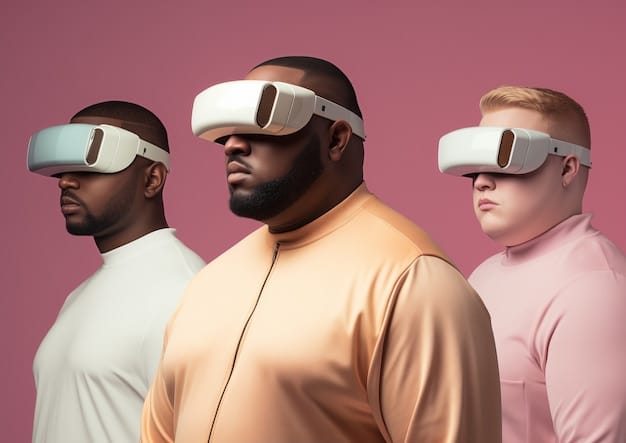US VR/AR Market: Growth Opportunities & Future Trends

The US virtual reality and augmented reality market is experiencing significant growth, driven by technological advancements, diverse applications across sectors, and increasing consumer adoption, presenting substantial opportunities for innovation and investment in the immersive tech landscape.
The landscape of immersive technologies within the United States is undergoing a profound transformation, with the US Virtual Reality (VR) and Augmented Reality (AR) Market: Growth Opportunities emerging as a focal point for innovation and investment. This evolving sector promises to redefine how we interact with digital content and the physical world around us, moving beyond mere entertainment to practical applications in various industries.
Understanding the immersive landscape
The present state of the US VR and AR market is characterized by rapid evolution and increasing adoption across sectors. While early VR iterations focused largely on gaming and entertainment, the technology has matured, finding significant traction in enterprise solutions, healthcare, education, and retail. Similarly, AR, often more accessible via smartphones and tablets, is enhancing daily experiences and professional workflows by overlaying digital information onto the real world. This dual growth is fueled by continuous technological advancements, making devices more powerful, portable, and affordable. Improvements in display resolution, processing power, battery life, and spatial tracking are collectively enhancing user experience and broadening the scope of potential applications. The synergy between hardware and software development is critical, as more intuitive interfaces and robust content ecosystems encourage wider acceptance.
technological breakthroughs driving market expansion
Recent years have witnessed several pivotal technological breakthroughs that are directly contributing to the expansion of the VR and AR markets. These advancements span across various components, each playing a crucial role in enhancing the immersive experience and opening new avenues for application.
- Advanced display technologies: Micro-LED and OLED displays offer higher pixel densities and wider fields of view, significantly reducing the “screen-door effect” and improving visual fidelity.
- Improved spatial tracking: Inside-out tracking, powered by advanced sensors and AI algorithms, allows users greater freedom of movement without external base stations, making VR more accessible and less cumbersome.
- 5G connectivity integration: The rollout of 5G networks is enabling lower latency and higher bandwidth, crucial for cloud-based VR and AR experiences, facilitating complex graphics rendering and real-time interactions.
- Miniaturization of components: Smaller, more efficient processors and batteries are allowing for sleeker, lighter head-mounted displays (HMDs), improving comfort for extended use.
This continuous push for innovation means that today’s VR and AR experiences are far more compelling than those of just a few years ago. The industry is moving towards more integrated and seamless devices, with an increasing focus on addressing previous barriers to adoption such as cost, comfort, and content availability. Consequently, the market is no longer niche but is beginning to penetrate mainstream consciousness and enterprise operations.
The sustained investment in research and development by major tech companies and startups alike signals confidence in the long-term potential of these technologies. This investment is not just in hardware but also in foundational software, development tools, and content creation platforms, all of which contribute to a richer and more accessible ecosystem. The cumulative effect of these technological strides is a more robust and inviting market for both consumers and businesses, setting the stage for significant growth.
The initial phase of market development was largely characterized by experimental applications and early adopter enthusiasm. However, the current phase is marked by a clear shift towards practical, scalable solutions that address real-world problems. This transition is essential for securing sustained growth and integrating VR and AR into the fabric of everyday life and professional activities. Without a solid foundation of useful applications, even the most advanced technology struggles to achieve widespread adoption. The industry’s ability to demonstrate tangible benefits will be key to its continued success.
A deeper look into the specifics of these technological leaps reveals how they coalesce to create more powerful and versatile solutions. For example, the interplay between improved optics and haptics is creating more believable and tactile virtual environments, moving beyond purely visual experiences. As these technologies mature, they will increasingly blur the lines between the physical and digital, leading to truly immersive and interactive applications that were once confined to science fiction.
Key industries embracing VR and AR
The burgeoning US VR and AR market is finding fertile ground across a diverse array of industries, each discovering unique applications that enhance efficiency, engagement, and effectiveness. Beyond the well-known realm of gaming, these immersive technologies are proving to be invaluable tools for innovation and problem-solving in sectors ranging from healthcare to manufacturing. The adaptability of VR and AR allows for tailored solutions that address specific industry needs, driving productivity and fostering new modes of interaction.
healthcare innovation through immersive tech
In the healthcare sector, VR and AR are revolutionizing training, therapy, and surgical procedures. Medical professionals are utilizing VR for realistic surgical simulations, allowing them to practice complex operations without risk to patients. This virtual training environment provides an unparalleled opportunity for skill development and repetition. AR, on the other hand, is being employed to overlay patient data during surgery, providing surgeons with critical information in real-time, directly within their field of vision. This can enhance precision and reduce errors.
- Surgical training and planning: VR simulations offer immersive, hands-on practice for intricate procedures, improving surgical outcomes.
- Pain management and therapy: VR environments can distract patients from acute and chronic pain, serving as a non-pharmacological intervention.
- Rehabilitation: AR applications aid in physical therapy, making exercises more interactive and engaging, motivating patients during their recovery.
- Medical education: Students can explore human anatomy in 3D, providing a detailed and interactive learning experience that surpasses traditional methods.
These applications are not only improving patient care but also streamlining healthcare education and professional development. The ability to simulate real-world scenarios in a controlled environment is invaluable, allowing for mistakes to be made and learned from without real-world consequences. This safe space for experimentation promotes faster learning and greater confidence among healthcare practitioners. The integration of these technologies also promises to make specialized medical training more accessible, especially in remote areas where traditional training resources might be limited.
transforming manufacturing and design
The manufacturing and design industries are leveraging VR and AR to optimize workflows, facilitate collaborative design, and enhance maintenance procedures. Designers are using VR to visualize prototypes in 3D, allowing for immersive reviews and quick iterations before physical production begins. This can significantly reduce development time and cost. AR is used on factory floors to provide technicians with step-by-step instructions overlaid on machinery, simplifying complex assembly tasks and maintenance operations.
- Product prototyping and visualization: Creating virtual models allows for immersive review and iterative design, speeding up the development cycle.
- Assembly and maintenance assistance: AR overlays guide workers through complex procedures, increasing efficiency and reducing errors.
- Quality control: AR can highlight defects or deviations from design specifications, ensuring higher quality products.
- Employee training: Immersive simulations provide safe and effective training for operating machinery or navigating dangerous environments.
These applications not only boost efficiency but also enhance safety by providing realistic training scenarios and reducing the need for physical interaction with hazardous machinery. The ability to collaborate on designs in a shared virtual space, regardless of geographical location, is also a significant advantage, fostering international cooperation and accelerating innovation. The adoption of VR and AR in these sectors is redefining how products are conceptualized, built, and maintained, leading to leaner and more agile operations.
The impact of these technologies extends beyond mere operational improvements; they are fundamentally changing the nature of work in these industries. By providing tools that augment human capabilities, VR and AR are enabling workers to perform tasks with greater precision, speed, and safety. This translates to higher quality outputs, reduced waste, and a more competitive edge in a global marketplace. The continued integration of immersive technologies is poised to drive the next wave of industrial productivity.
Investment trends and market forecasts
The US VR and AR market is attracting substantial investment, driven by the compelling potential for disruption and growth across various sectors. Venture capital firms, tech giants, and corporate strategists are all channeling significant funds into startups and established players, signaling strong confidence in the industry’s future. This influx of capital is fueling research and development, content creation, and market expansion efforts. The investment landscape is characterized by a strategic focus on scalable solutions and innovative applications that can deliver tangible value to both consumers and enterprises.
venture capital and corporate acquisitions
Venture capital (VC) funding in the VR and AR space has seen a steady increase, with investors keen on backing companies that demonstrate strong technological differentiation and clear market pathways. Notable investments have been observed in areas such as haptic feedback technologies, advanced optics, and specialized content platforms. Beyond VC, major tech corporations are actively acquiring smaller VR and AR companies to integrate their unique capabilities and intellectual property into larger ecosystems. These acquisitions often target companies with expertise in areas like 3D content creation, spatial computing, or specific enterprise solutions.
- Strategic investments: Funding rounds are increasingly focused on companies developing next-generation hardware components and enabling software platforms.
- Consolidating market share: Larger companies are acquiring smaller innovators to gain competitive advantage and expand their technological portfolios.
- Partnerships and collaborations: Joint ventures between hardware manufacturers and content developers are becoming common to create integrated user experiences.
- Incubator programs: Many tech hubs and corporate accelerators are offering mentorship and funding to early-stage VR/AR startups.
This M&A activity and venture funding underline a broader trend of consolidation and strategic alignment within the industry. Companies are seeking to build comprehensive ecosystems that seamlessly integrate hardware, software, and content, thereby offering more complete solutions to end-users. The competition for talent and innovative ideas is fierce, leading to higher valuations for promising startups. This environment encourages further innovation, as entrepreneurs are motivated by the prospect of significant returns on their breakthroughs.
The continuous flow of capital ensures that research and development efforts remain robust, allowing for the rapid iteration and improvement of technologies. Without this sustained financial backing, many groundbreaking ideas would never make it past the conceptual stage. The investment dynamics also reflect the evolving understanding of where the most significant opportunities lie, with a growing emphasis on practical, rather than purely speculative, applications of VR and AR. This shift from novelty to utility is crucial for long-term market stability.
market size and growth projections
Analysts are projecting substantial growth for the US VR and AR market over the next decade. While initial forecasts were sometimes overly optimistic, current projections are more grounded, reflecting a clearer understanding of adoption curves and industry challenges. The market is segmented into various components, including hardware (headsets, peripherals), software (operating systems, development tools), and content (games, enterprise applications). Each segment is expected to contribute to the overall growth, albeit at different rates. The enterprise segment, in particular, is anticipated to be a major growth driver, as businesses increasingly realize the efficiency and productivity gains offered by immersive technologies.
- Hardware sales: Continued innovation in standalone headsets is expected to drive consumer adoption, while enterprise solutions will boost professional-grade device sales.
- Software and platform revenue: Subscription models for enterprise software and in-app purchases for consumer content will contribute significantly to revenue.
- Content creation services: The demand for bespoke VR/AR content for training, marketing, and entertainment will fuel growth in service providers.
- Strategic partnerships: Collaborations between traditional industries and immersive tech companies will unlock new revenue streams and market segments.
These projections are underpinned by several factors, including the increasing computational power of devices, the expanding availability of high-speed internet, and the growing familiarity of the general public with immersive experiences. However, the market’s trajectory is not without its challenges, such as the need for more compelling content, continued improvements in user comfort, and the establishment of common industry standards. Despite these hurdles, the overall outlook remains positive, with VR and AR poised to become an integral part of the digital economy.
The accuracy of these forecasts relies heavily on the industry’s ability to overcome existing barriers to adoption and deliver on the promise of truly transformative experiences. As more robust and user-friendly products enter the market, the addressable audience will expand, driving sustained revenue growth. The potential for these technologies to revolutionize a myriad of industries means that their long-term impact could be even larger than currently projected, making this a critical area for ongoing observation and analysis.
Challenges and opportunities
The rapid evolution of the US VR and AR market, while promising, is not without its significant challenges. These hurdles encompass technical limitations, user experience issues, and broader market adoption dynamics. Addressing these challenges effectively will be crucial for the industry to realize its full potential and move beyond its current growth phase into widespread integration. However, these very challenges often present unique opportunities for innovation and competitive differentiation.
overcoming technical hurdles and content gaps
Despite notable advancements, technical limitations persist within VR and AR. These include issues with resolution, processing power, battery life, and the “uncanny valley” effect, where realistic virtual representations still fall short of truly convincing human likenesses. Additionally, the development of compelling and diversified content remains a critical challenge. The market, especially on the consumer side, is still largely driven by gaming, and a wider array of engaging applications is needed to attract a broader audience.
- Hardware limitations: Devices need to become lighter, more comfortable, and offer higher resolution and wider fields of view without sacrificing performance or affordability.
- Content scarcity: There is a strong demand for high-quality, non-gaming content, including educational experiences, social platforms, and productivity tools.
- Interoperability issues: A lack of standardized platforms and formats creates fragmentation, hindering content portability and user choice.
- User interface complexity: Navigating virtual environments can still be unintuitive for new users, requiring more natural and accessible interaction methods.
Addressing these technical hurdles requires continued investment in research and development, pushing the boundaries of what is possible with current technology. Overcoming content gaps, on the other hand, necessitates fostering a vibrant developer ecosystem, encouraging creativity and supporting diverse content pipelines. Providing accessible development tools and clear monetization pathways will be key to attracting more content creators. The industry must also work towards greater interoperability to ensure a seamless experience across different devices and platforms, which will ultimately benefit both developers and consumers.
The opportunity here lies in solving these complex problems: companies that can deliver significant breakthroughs in hardware performance, or create truly compelling and unique immersive experiences, stand to gain substantial market share. The need for intuitive and user-friendly interfaces also opens doors for innovation in interaction design, moving beyond traditional controllers to more natural forms of input. This continuous drive for improvement is a hallmark of nascent but rapidly maturing technologies.
ensuring accessibility and ethical considerations
As VR and AR technologies become more pervasive, ensuring accessibility for all users, regardless of physical ability, is paramount. This includes designing interfaces and experiences that are inclusive of individuals with disabilities. Beyond accessibility, profound ethical considerations arise with the increasing immersion and data collection capabilities of these technologies. Issues around user privacy, data security, digital identity, and the potential for addiction or misuse need careful consideration and proactive solutions.
- Designing for inclusivity: Developing features that support users with visual, auditory, or motor impairments in engaging with VR/AR content.
- Data privacy and security: Establishing robust protocols for how user data, especially biometric data, is collected, stored, and utilized in immersive environments.
- Combating misinformation: Addressing the potential for deepfakes and manipulation of virtual realities to spread false information.
- Mental health impact: Studying the long-term psychological effects of prolonged VR/AR use and developing guidelines for responsible usage.
The opportunity presented by these challenges is the chance to build a more responsible and ethical immersive environment from the ground up. Companies that prioritize ethical design, robust data protection, and transparent user policies will build trust and foster long-term adoption. Investing in accessibility features not only broadens the market reach but also demonstrates a commitment to social responsibility. Addressing the potential for negative societal impacts proactively will be crucial in ensuring that VR and AR evolve in a way that benefits humanity.
Developing industry-wide best practices and potentially regulatory frameworks will be essential to navigate these complex ethical landscapes. Collaborations between technology providers, policymakers, and civil society organizations can help establish guidelines that promote responsible innovation while safeguarding user well-being. The ethical implications are not just technical problems but societal ones, requiring a multi-faceted approach to ensure that these powerful technologies are used for good.
Regulatory landscape and standardization efforts
The nascent state of the US VR and AR market means that the regulatory landscape is still largely undefined, presenting both an opportunity and a challenge. Governments and industry bodies are beginning to grapple with how to govern these rapidly evolving technologies, particularly concerning data privacy, user safety, and content moderation. Standardization efforts are also underway, aiming to foster interoperability and ensure a consistent user experience across different platforms and devices. The outcomes of these discussions will significantly influence the market’s future trajectory.
privacy concerns and data governance
One of the most pressing regulatory concerns for VR and AR is data privacy. Immersive technologies have the potential to collect vast amounts of highly personal data, including biometric information, gaze tracking, spatial awareness, and even real-time emotional responses. Existing privacy legislation, such as the California Consumer Privacy Act (CCPA) and the general principles of GDPR, provide some foundational guidance, but specific regulations tailored to the unique data collection capabilities of VR/AR are still emerging. The challenge lies in balancing innovation with robust consumer protection.
- Biometric data collection: Regulations are needed to govern the collection and use of eye-tracking data, facial expressions, and physiological responses within VR/AR.
- Spatial data privacy: How indoor maps and personal environment data, captured by AR devices, are stored and shared raises concerns about individuals’ private spaces.
- Cross-platform data sharing: Establishing clear rules for data flow between different VR/AR applications and platforms is essential for user control.
- Children’s privacy: Specific protections for minors in immersive environments, similar to COPPA, may be required given the potential for data exploitation.
The opportunity for companies in this space is to proactively build privacy-by-design into their products and services. Demonstrating a clear commitment to user privacy can be a significant competitive advantage and build consumer trust. Engaging with policymakers to help shape sensible regulations can also ensure that future laws are workable and promote responsible innovation, rather than stifling it. Clear consent mechanisms and transparent data practices will be key differentiators in a competitive market.
The dynamic nature of data collection in immersive environments means that existing regulatory frameworks are often insufficient. Policymakers face the complex task of creating flexible regulations that can adapt to future technological advancements without becoming obsolete. This requires ongoing dialogue between industry experts, legal scholars, and government agencies to ensure that technological progress is accompanied by appropriate ethical and legal safeguards that protect individuals while enabling beneficial advancements.
interoperability and industry standards
The current VR and AR market is characterized by a degree of fragmentation, with various hardware manufacturers and software platforms operating within their own ecosystems. This lack of universal interoperability can hinder widespread adoption, as users may be locked into specific platforms or find it difficult to transfer content between devices. Standardization efforts are therefore crucial to create a more cohesive and user-friendly experience. Organizations like the IEEE and OpenXR are working to establish common APIs and technical specifications.
- Hardware compatibility: Developing universal connectors and protocols to ensure that peripherals and accessories work across different headsets.
- Content portability: Establishing common file formats and rendering engines so that VR/AR content can be easily accessed and experienced on multiple platforms.
- User interface consistency: Promoting consistent interaction models and navigation paradigms to reduce the learning curve for new users.
- Cloud rendering standards: Defining protocols for offloading computational tasks to the cloud, crucial for untethered VR/AR experiences.
The opportunity here lies in leading the charge on standardization, either by advocating for open industry standards or by developing proprietary solutions that become de facto standards due to their superior performance or widespread adoption. Companies that actively participate in these standardization bodies can influence the future direction of the market and position themselves as key players. Interoperability fosters a healthier ecosystem, encouraging more content creation and broader consumer choice, which ultimately benefits the entire industry.
The process of establishing industry standards is often slow and requires extensive collaboration among competitors. However, the long-term benefits of a more unified ecosystem are substantial, reducing development costs for content creators and offering greater flexibility for consumers. A shared technical foundation can accelerate innovation by allowing developers to focus on unique features and content rather than grappling with fragmented hardware and software environments. This collaborative approach will be vital for the sustained growth and maturity of the VR and AR markets.
Future outlook and emerging trends
The US VR and AR market is poised for continued transformation, driven by emerging trends and a convergence of technological advancements. As these immersive technologies mature, they are expected to become increasingly integrated into daily life and professional workflows, moving beyond dedicated devices to more ubiquitous and context-aware experiences. The future outlook points towards a significant expansion in both consumer and enterprise applications, underpinned by ongoing innovation and a growing understanding of their practical utility.
the metaverse and spatial computing
A significant emerging trend is the concept of the metaverse, a persistent, interconnected virtual world that blends elements of VR, AR, and traditional internet use. While still in its early stages of development, the metaverse envisions a future where digital and physical realities seamlessly merge, allowing users to socialize, work, shop, and play in immersive environments. Spatial computing, which enables devices to understand and interact with the physical world in three dimensions, is a foundational technology for the metaverse, allowing AR experiences to become more sophisticated and context-aware.
- Persistent virtual worlds: The development of shared, always-on digital spaces where users can interact regardless of physical location.
- Digital twins and replicas: Creating highly accurate virtual representations of real-world objects, places, and even individuals for simulated interactions.
- Interoperability across platforms: Efforts to ensure that digital assets and identities can be transferred seamlessly between different metaverse experiences.
- Ubiquitous AR: The integration of AR into everyday objects and environments, making information and interactions available on demand.
The metaverse represents a vast opportunity for VR and AR, potentially unlocking new economic models, social interactions, and creative expressions. As spatial computing capabilities advance, AR will become less about overlaying information and more about creating truly interactive interfaces within the physical world. This shift will make augmented experiences more intuitive and deeply integrated into our understanding of reality. The journey to a fully realized metaverse will be incremental, driven by shared industry protocols and innovative content creation.
The development of the metaverse also raises complex questions about governance, digital ethics, and the nature of ownership in virtual spaces. However, the potential for economic growth and societal impact is immense, attracting significant investment and talent. The convergence of VR and AR into a broader metaverse vision suggests a future where immersive technologies are not just tools but foundational layers of our digital existence, offering unprecedented levels of connection and interaction.
AI integration and haptic feedback innovation
Artificial intelligence (AI) is set to play an increasingly critical role in enhancing VR and AR experiences. AI can personalize content, optimize rendering, and create more intelligent virtual characters and environments. For instance, AI-powered natural language processing could enable more sophisticated voice interactions within VR, while machine learning could adapt AR displays based on user behavior and preferences. Alongside AI, advancements in haptic feedback technology are crucial for making immersive experiences truly believable. Haptic devices provide tactile sensations that simulate touch, pushing user immersion far beyond visual and auditory inputs.
- Intelligent virtual assistants: AI-powered characters and guides within VR/AR that respond contextually and learn from user interactions.
- Dynamic content generation: AI algorithms that can generate realistic virtual environments or adapt existing content based on user input or preferences.
- Enhanced tactile experiences: More sophisticated haptic gloves and suits that provide nuanced sensations of pressure, texture, and temperature.
- Neuromorphic computing for HMDs: Energy-efficient AI chips within headsets that enable more complex on-device processing and autonomy.
The integration of AI will make VR and AR experiences more adaptive, personal, and intelligent, moving away from static content towards dynamic and responsive interactions. Haptic feedback innovation, meanwhile, addresses a fundamental gap in current immersive technologies by adding a sense of touch that significantly enhances realism and presence. As these technologies mature and converge, they will create experiences that are not only visually and audibly compelling but also physically engaging, blurring the lines between the digital and the real.
The future is likely to see increasingly sophisticated AI models built directly into VR/AR hardware, enabling features like real-time object recognition for AR, or highly realistic physics simulations within VR. Similarly, haptic technology will move beyond simple vibrations to deliver complex tactile sensations, making virtual objects feel tangible. These advancements will be pivotal in driving mass adoption, as they address core aspects of human perception and create truly believable immersive environments that resonate on a deeper level.
Transforming enterprise and remote work
The US VR and AR market’s most significant and immediate impact is increasingly felt within the enterprise sector, particularly in redefining remote work. As businesses seek to optimize operations, enhance collaboration, and streamline training in a globally connected landscape, immersive technologies offer compelling solutions. The ability to create shared virtual spaces and augment physical environments is proving invaluable for efficiency and engagement, pointing towards a future where work transcends geographical boundaries.
virtual collaboration and distant learning
VR and AR are revolutionizing virtual collaboration, allowing teams to meet and work together in immersive digital environments regardless of their physical location. This goes beyond traditional video conferencing, providing a sense of presence and interactivity that mirrors in-person meetings. In distant learning, both corporate training and educational institutions are leveraging VR to create highly engaging and interactive simulated learning experiences, offering practical skills development in risk-free environments.
- Immersive meeting spaces: Virtual rooms where participants can interact with 3D models, whiteboards, and presentations as if in person.
- Enhanced remote training simulations: Realistic virtual environments for vocational training, emergency preparedness, and complex skills acquisition.
- Cross-functional design reviews: Teams can collaboratively inspect and modify product designs in a shared virtual space, accelerating development cycles.
- Global team building: Immersive social platforms that foster stronger connections and a sense of shared community among distributed workforces.
The shift towards hybrid and remote work models has accelerated the adoption of these technologies, as companies seek to maintain productivity and foster a strong company culture in a distributed environment. VR offers a solution to “Zoom fatigue” by providing a more engaging and less draining alternative to two-dimensional video calls. In education, the ability to practice complex procedures or explore abstract concepts in an immersive 3D space significantly enhances comprehension and retention, providing a richer learning experience than traditional methods.
The economic benefits for businesses are substantial, including reduced travel costs, improved training effectiveness, and faster product development cycles. These tangible gains are driving greater investment in enterprise-grade VR and AR solutions, as companies recognize their potential to create a competitive advantage. The future of work is likely to be significantly shaped by these immersive collaboration tools, making distributed teams more cohesive and powerful than ever before.
industrial applications and workforce empowerment
Beyond traditional office settings, VR and AR are also making significant inroads into industrial applications, empowering frontline workers and optimizing complex operations. From field service to manufacturing and logistics, these technologies provide vital information and training directly within the worker’s field of view. This augmentation minimizes errors, enhances safety, and significantly improves efficiency, leading to a more skilled and agile workforce.
- Remote expert assistance: AR overlays can guide technicians through repairs or complex tasks, with remote experts providing real-time visual instructions.
- Digital work instructions: Step-by-step guidance overlaid onto machinery or real-world objects, reducing reliance on paper manuals and speeding up processes.
- Safety training simulations: Immersive VR environments for practicing dangerous procedures or emergency evacuations without physical risk.
- Predictive maintenance with AR: Overlaying sensor data and maintenance schedules onto machinery, enabling proactive repairs and reducing downtime.
These industrial applications are transforming how work is performed, moving towards a model where information is contextually available and actionable. By providing workers with immediate access to critical data and expert guidance, AR reduces errors, speeds up task completion, and minimizes training time. VR, through its ability to simulate realistic scenarios, offers a safe and cost-effective way to train employees on highly specialized or dangerous tasks. The net effect is a more productive, safer, and highly skilled workforce, capable of tackling complex challenges with greater confidence.
The investment in these technologies represents a commitment to workforce empowerment, providing tools that amplify human capabilities rather than replacing them. As industries embrace digital transformation, VR and AR will play a pivotal role in creating smart factories, efficient logistics chains, and highly responsive service operations. The long-term impact on global competitiveness and economic growth is expected to be profound, making these technologies indispensable for modern enterprise.
| Key Point | Brief Description |
|---|---|
| 🚀 Market Growth Drivers | Technological advancements, diverse industry adoption, increasing investment, and consumer interest fueling market expansion. |
| 🏥 Healthcare Impact | Revolutionizing surgical training, patient therapy, and medical education through immersive simulations and data overlays. |
| 💼 Enterprise Transformation | Enhancing remote collaboration, industrial training, and operational efficiency across various business sectors. |
| 🔮 Future Trends | Metaverse development, AI integration, and advanced haptics defining the next generation of immersive experiences. |
Frequently asked questions about the US VR and AR market
▼
The growth is primarily fueled by continuous technological advancements in hardware and software, increasing investment from venture capital and tech giants, and the expansion of applications beyond gaming into critical sectors like healthcare, manufacturing, and remote work. Improved user experience and device accessibility also play a significant role.
▼
In healthcare, VR is indispensable for realistic surgical training and simulations, allowing medical professionals to practice complex procedures safely. AR is used to overlay patient data during surgery, aiding in precision. Both technologies are also employed for pain management, physical rehabilitation, and advanced medical education, offering immersive and interactive learning experiences.
▼
Key challenges include technical limitations like resolution and battery life, a shortage of diverse and compelling content beyond gaming, issues with interoperability between platforms, and establishing user interface simplicity. Addressing ethical concerns such as data privacy and ensuring accessibility for all users are also critical hurdles.
▼
The metaverse is an emerging concept envisioning a persistent, interconnected virtual world that seamlessly blends VR, AR, and traditional internet use. VR gives access to fully immersive virtual spaces, while AR overlays digital content onto the physical world. Both are foundational technologies for building and navigating this future digital realm.
▼
VR and AR facilitate enhanced virtual collaboration through immersive meeting spaces, offering a more engaging alternative to traditional video conferences. They are crucial for remote training and distant learning, providing realistic simulations for skill development. In industrial settings, AR empowers frontline workers with real-time information, improving efficiency and safety.
Conclusion
The US Virtual Reality (VR) and Augmented Reality (AR) Market stands at the precipice of remarkable transformation, driven by an accelerating pace of innovation and an ever-broadening spectrum of applications. From entertainment to critical enterprise functions, these immersive technologies are no longer speculative concepts but powerful tools reshaping industries and human interaction. While significant hurdles relating to technical capabilities, content ecosystems, and ethical considerations remain, the consistent influx of investment and the growing maturity of foundational technologies suggest a trajectory of substantial growth. As the market continues to evolve, understanding and adapting to these dynamic shifts will be paramount for stakeholders aiming to capitalize on the vast opportunities within this exciting frontier.





